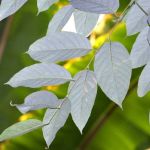| Common Name: |
Gum Benjamin |
| Other Names: |
Benzoin |
| Botanical Name: |
Styrax benzoin |
| Family: |
Styracaceae |
| Native Location: |
Cambodia, Java, Laos, Sumatra, Thailand, Vietnam, Indonesia |
| Cultivation: |
Moist to wet soil in sun or partial shade. |
| Propagation: |
By seed sown when ripe; by greenwood cuttings in summer. |
| Harvest: |
Gum is collected from deep incisions made in the trunks of trees at least 7 years old. Hardened gum is stored in pieces ("tears"), compressed into a solid mass, or made into tinctures. |
| Height: |
8m (25ft) |
| Width: |
5-6m (15-20ft) |
| Hardiness: |
Min. 15-18°C (59-64°F) |
| Extraction: |
Solvent extraction |
| Parts Used: |
Gum resin (an xi xing) |
| Color and Odor: |
Benzoin resinoid is thick and dark golden brown in color, having a most pleasant aroma resembling vanilla. It is one the heavier oils and is an excellent fixative. |
| Background: |
Long used in antiquity as an incense. Known in Europe during the Middle Ages when it was used as a compound tincture for inhalation. It was then called "Friar's Balsam". |
| Properties: |
Warming, energizing, circulatory stimulant, sedative, decongesting, expectorant, diuretic, carminative.
An astringent, expectorant, and antiseptic herb with a cinnamon-camphor aroma. It is regarded as a circulatory stimulant in Chinese medicine and as a sedative in aromatherapy. |
| Note: |
Benzoin is a resinoid and cannot be obtained as a pure essential oil. The resinoid is the natural extract from the tree, which is then diluted with a solvent (benzyl alcohol). This makes it easier to pour and handle, as the natural product is very thick and difficult to use. |
| Uses: |
- Urinary Sytem—Antiseptic property good for cystitis.
- Respiratory System—Tonic to the lungs. Effective for colds, flu, bronchitis and asthma, clearing and expelling congested mucus. Also good for coughs, sore throat and loss of voice.
- Reproductive Sytem—Excellent for leucorrhoea.
- Muscular System—Good for rheumatism.
- Skin—Soothing for conditiosn where there is redness, irritation and itching, such as cracked skin or chapped hands chillblains and dermatitis. A good remedy for wounds and sores.
- Emotions—Calming and comforting for crisis states involving sadness, loneliness, depression and anxiety. Especially good for dispelling anger. In times of great exertion, benzoin eases emotional exhaustion, is energizing and increases physical strength. The scent of benzoin stimulates the concious mind and counteracts indifference. Benzoin is protective against life's crisis. It also releases past tensions and resentments.
|
| Medicinal Uses: |
In Western medicine, internally for coughs, colds, bronchitis, sore throat, wounds, ulcers, and mouth ulcers; externally for wounds and ulcers. An ingredient of cough and cold remedies, such as Friar's Balsam. In Chinese medicine, internally for chest and abdominal pains. In aromatherapy for influenza, chills, and itching skin conditions. |
| Economic Uses: |
Used as an anti-oxidant in cosmetics, a fixative in perfumes, and as s flavoring in the food industry. |
| Blends: |
| URINARY |
RESPIRATORY |
REPRODUCTIVE |
| Benzoin 7 |
Benzoin 6 |
Benzoin 6 |
| Celery 4 |
Eucalyptus 5 |
Sandalwood 3 |
| Niaouli 2 |
Thyme 3 |
Bergamot 3 |
|
| MUSCULAR |
SKIN |
EMOTION |
| Benzoin 7 |
Benzoin 5 |
Benzoin 6 |
| Marjoram 4 |
Myrrh 2 |
Rose 4 |
| Juniper 3 |
Chamomile (R) 2 |
Clary Sage 2 |
| Bibliography: |
Aromatherapy Blends and recipes by Franzesca Watson Copyright © 1995 Thorsons, Harper Parker Publishing Inc. Pp 60-61
The Encyclopedia of Herbs by Deni Bown copyright © 1995, 2001 Dorling Kindersley Limited. pp 376-377 |
|

